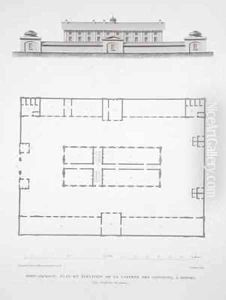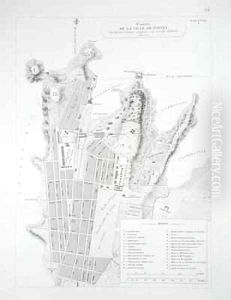Louis Claude Desaulses de Freycinet Paintings
Louis Claude Desaulses de Freycinet was a French navigator, explorer, and a significant figure in the French contribution to the exploration of the Pacific region during the early 19th century. He was not an artist in the traditional sense, but his work did include the creation of maps and charts that were both scientifically important and artistically executed. Born on August 7, 1779, in Montélimar, France, de Freycinet was a man of the Enlightenment, whose career was dedicated to science and exploration.
De Freycinet joined the French navy in 1793 during a turbulent period in French history marked by the French Revolution and the Napoleonic Wars. Despite the political upheaval, France continued to invest in voyages of discovery. In 1800, de Freycinet was selected to participate in a scientific expedition aboard the Naturaliste, which was part of an exploratory trip led by Nicolas Baudin. This journey, known as the Baudin expedition to Australia (1800-1804), was intended to chart the coast of the then little-known continent and advance the scientific knowledge of the region.
During the expedition, de Freycinet was responsible for cartography and surveying. His skill and precision in these tasks earned him recognition, and he was entrusted with the command of the ship's longboat, used for close-inshore work. The maps and coastal charts he created during this voyage were remarkable for their accuracy and detail. After returning to France, de Freycinet played a key role in preparing the official records of the expedition, which included a historic map that depicted Australia's full coastline for the first time.
Furthering his career as an explorer, de Freycinet led his own expedition aboard the Uranie in 1817, with the aim of circumnavigating the globe and gathering additional scientific information. Accompanied by his wife, Rose de Freycinet, who disguised herself as a man to join the voyage, he made significant contributions to the fields of geography, biology, and ethnography. The voyage was marked by numerous hardships, including the wreck of the Uranie on the Falkland Islands in 1820. Despite these challenges, the expedition collected a wealth of scientific data and specimens.
De Freycinet's legacy includes not only the geographic knowledge he contributed but also a body of work that would influence future explorers and navigators. His maps and observations proved to be invaluable resources for many years. He died on August 18, 1842, in Freycinet, a testament to his life's work dedicated to the advancement of science and exploration. His name is commemorated in various geographic features, such as the Freycinet Peninsula in Tasmania and the Freycinet National Park.

